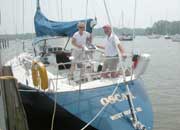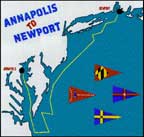|

|
 Heart, Sea Legs and Half a Million Dollars Heart, Sea Legs and Half a Million Dollars
That’s what it takes to join the historic sailing race from Annapolis to Newport
by Maureen Miller
On June 15, 1947, as 36 entries assembled for the Annapolis to Newport Race, N. T. Kenney described them in the Baltimore Sun as “$1,000,000 worth of the country’s best seagoing sailing yachts.”
On June 10, 2005, $24 million worth of the country’s best seagoing sailing yachts will cross a starting line — near the outer end of the Annapolis Harbor channel — at noon to begin the 28th sailing of this race.
This historic East Coast blue water race links two seaports that date from our nation’s birth. The race has existed in various forms since 1871, when the course was Sandy Hook to Cape May. Between 1947 and the mid-’50s, boats started in Newport to finish in Annapolis. The course was reversed in 1957 after much complaining among competitors about ending a long ocean race with slow trips up the Chesapeake.
This year, some 50 boats will head south to the mouth of the Chesapeake, then north to Newport, Rhode Island, where they will cross the finish line — two to four days and 475 miles later. The record, established in 2001, by Carrera, Joseph Dockery’s Farr 60 skippered by Chris Larson, was 42 hours, 58 minutes, 12 seconds.
The Call of the Sea
What makes a captain and crew spend months in tedious preparation to race from Annapolis to Newport?
“Because it’s the best blue water race on the East Coast — maybe in the world,” replies Peter Bell, a member of this year’s Race Committee and a 1987 racer.
“It’s the challenge of an ocean race as well as a change of scenery for us local racers,” says David Kim, who is racing Lanikai, a Beneteau 40.7 in his third Annapolis Newport race.
Donna Schlegel, of Galesville, races for the fourth time, this year captaining Oscar, a 41-foot Frere. What she likes about blue water racing is the camaraderie.
“You’re together day and night for three to four days. You laugh work, eat, sleep, and keep watch together. It’s a unique experience,” Schlegel says.
It’s also a quick way, with plenty of help, Schlegel says, to get her boat north, where she will cruise off the coast of Maine.
This race is a favorite for first-time-off-shore competitors, as well as experienced blue water racers, because it challenges them over different bodies of water — the Chesapeake Bay and the Atlantic Ocean. It also provides a string of convenient ports of refuge.
Chip Thayer, Annapolis Yacht Club Race Committee Chairman, has raced 10 or 12 times. He best remembers the 1987 race.
“With a southerly blowing, the trip down the Bay was lumpy trash,” he says. “When we exited the Bay, however, that same southerly gave us a glorious ride up the coast, surfing down the big ocean rollers. And in sight, all the way up the coast, was the Naval Academy’s Morning Light. We beat her to Newport and finished three seconds ahead of her on corrected time, to take second in class.”
 Trials and Troubles Trials and Troubles
Ocean racing is never comfortable, as the boat is filled with regulation equipment and extra sails. Skipper and crew must abide by a 15-page compliance checklist, covering everything from lifelines and rafts to cooking facilities, drinking water, engines, generators and fuel.
Schlegel, who has every inch of space on her boat designated for a specific item, says she will carry more sails, 11, than crew, nine, on this race. “My crew will have to climb over those extra sails every time they need to go to the head,” she says.
Blue water racing is arduous, as well. At a moment’s notice, crew must be ready to change bearing, trim sails or set spinnakers to keep the boat on course and at top speed. On top of that, skipper and crew get only a few hours of sleep between watches.
Eighty-eight-year-old Lawrence Hartge, a retired marine surveyor, remembers his last Annapolis-Newport race as nothing but trouble.
“The person who owned the boat didn’t do all he was supposed to,” Hartge recalls. “So by the time we got down to the mouth of the Chesapeake, the boat was leaking, and we had no battery for the pumps. I did my watch, and when it came to the next watch I did that one, too, because everyone, including the owner, was down below, seasick. After three or four watches on my own, I said, ‘this is ridiculous. It’s too rough, everyone’s sick, and the boat is leaking, so I’m gonna turn around and go back.’ And we did.”
Watched by All-Seeing Eyes
Back in 1947, the Sun’s Kenney described the objects of this race as developing seaworthy yachts and able sailors.
The old reporter would find change in most everything but those goals. Especially in safety gear and communications, racing is a whole new world. Today’s racers sail under the watchful eyes of satellites. Boats must carry both a satellite transponder and a telephone.
Except in emergency, however, there can be no boat-to-boat communications. Sailors can link to the Internet, but they can’t use it for inside advantage. Any news they use, on weather and sea conditions for example, must be free and available to everyone in the fleet.
The Annapolis-based race committee of 30 organizes, registers, checks and starts the boats. Nine organizers then drive to Newport to join 10 Rhode Islanders in overseeing the finish.
“In the past, if they hadn’t finished we had no idea where they were or when they would finish,” says race chairman Thayer. “This year, thanks to the sponsorship of T. Rowe Price, we’ll have GPS tracking of all the boats, so a quick look on the Internet will give everyone this information.”
Where the Boats Are
In the days before the race, all boats come to Annapolis for inspection.
“The boats will be docked or moored all over the Annapolis area,” says race spokeswoman Holly Hughes Wilmer. “Visitors can walk around the harbor and see them.”
On the day of the race, Bell says the best land vantage for watching the noon start of the race is the Bay Ridge bluff. Farther down the Bay, look out from North Beach an hour or two later.
Once you’ve seen the boats pass, follow them on the Annapolis Yacht Club website: www.annapolisyc.org.
to top of page
 Wade a Minute Wade a Minute
Sneaking into better waters
by Carrie Steele
Toe the shoreline no more. From the Potomac to the Patapsco to the Eastern Shore, it’s season for stepping right in.
Leading the parade each year is former Sen. Bernie Fowler, 81, who has been seeking sight of his sneakers in waters of the Patuxent River for 17 years. Bernie’s Sneaker Index of water quality harkens back to his boyhood, when he could spy his shoes while wading chest deep.
“The wade-ins help keep the media’s focus on the Patuxent River and how water quality’s doing,” Fowler told Bay Weekly, adding that his wade-ins and efforts to restore the Bay make world-wide news.
But have restoration remedies been working?
“We’re stopping the patient from dying,” says Fowler. “We’ve stopped the bleeding, but we want this patient to walk again.”
If it hadn’t been for many restoration efforts, Fowler continued, the Bay would be a cesspool.
On May 22, on the Patapsco River, Fowler led 30 waders to glimpse their sneakers at 16 inches, while swimmers Joe Stewart and Susan Wilkinson Megaw crossed the 4.4-mile river.
On June 4, Annapolitans stepped into creeks and rivers. Mayor Ellen Moyer watched from the banks as over 15 waders walked an official 19 inches deep — two inches farther than last year — into Back Creek. “There was some turbidity, so there’s still a need for improvement,” said spokeswoman Marisa Wittlinger.
Also improved in Annapolis was College Creek, where waders measured 19 inches, 10 inches deeper than last year. But Weems Creek fared worse; waders’ sneakers disappeared at 32 inchs, eight less than last year. At Spa Creek, clarity dropped to a mere six inches from last year’s 13.
On the Bush River at Abingdon in Baltimore County, some 180 waders lost sight of their feet at 14 inches, 11 less than last year. “It had a lot to do with the rain Friday. It really depends on weather,” said Department of Natural Resources’ Carrie Decker.
More than 200 waders at the upper Eastern Shore’s Wade-In at Chesapeake Bay Environmental Center in Grasonville saw their feet at 28 inches, six inches deeper than last year and a full foot more than two years ago.
Wade-ins continue, with family-friendly festivities:
- June 9: Lower Western Shore Magothy River Wade-In, 6pm, Sylvan View community beach (Mountain Rd. to Hickory Point Rd.; right on Gray Dr.; left on Sylview Dr.), Pasadena.
- June 11: Lower Potomac Wade-In, 10am-2pm (noon wade-in), Mirant Mid-Atlantic Morgantown Generating Plant (last left before the Rt. 301 Governor Nice Bridge).
- June 12: Bernie Fowler Day on the Patuxent: 2pm, Broomes Island (Rt. 2-4 to Rt. 264), Calvert County.
- June 18: Lower Western Shore & South River Federation Sojourn and Wade-In, 8:30am paddle to Edgewater Beach from Quiet Waters Park; noon wade-in, Edgewater Beach.
to top of page
|
